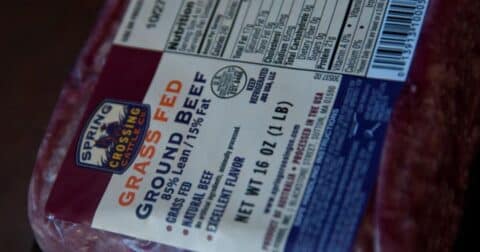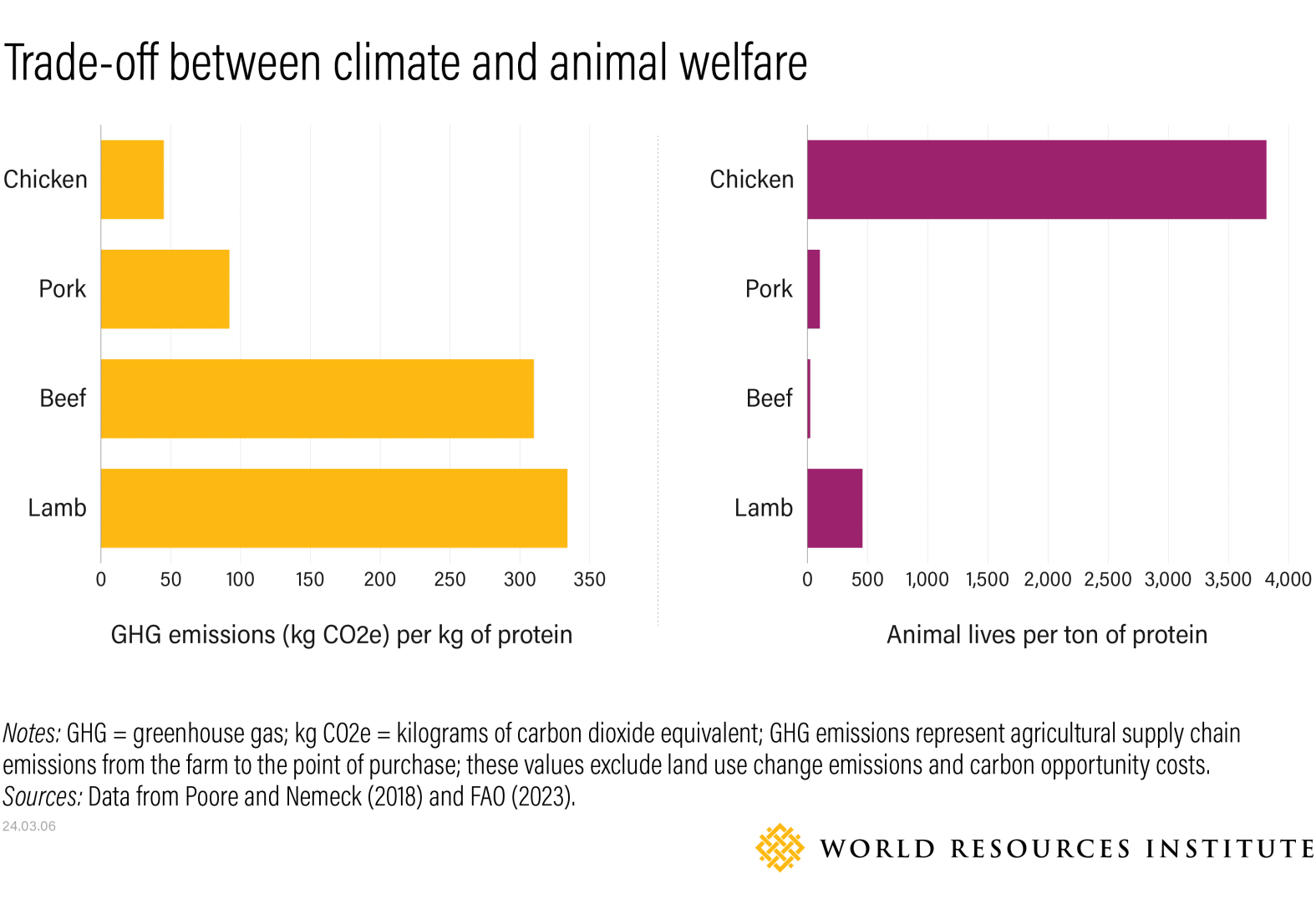Explainer
How Overconsumption Affects the Environment and Health, Explained
Climate•12 min read
Solutions
Research suggests grass-fed meat has a higher carbon footprint.


Words by Jessica Scott-Reid
In 2007, famed American author Michael Pollan wrote this now famous quote: “Eat food. Not too much. Mostly plants.” The quote remains as relevant today as ever, with movements like flexitarianism, reducetarianism and Meatless Mondays to help people cut back on meat. But a new report from the World Resources Institute suggests one favorite tactic of the less-meat movement — dubbed ‘less meat, better meat’ — comes with some challenging tradeoffs. There’s an inconvenient truth: meat that is “better” in some aspects — like animal welfare and soil health — can be worse for climate emissions. But with the food we eat contributing more than a quarter of all greenhouse gas emissions and billions of animals slaughtered each year, it’s important to get it right.
At first glance, the strategy is pretty much as it sounds — cut back on meat, and make sure the meat you do eat is better. But what makes one kind of meat “better” than another is a matter of fierce debate.
According to the World Resources Institute’s new report, common examples of “better meat” include organic, free-range and grass-fed options. A 2020 paper in Nature Food found an even wider variety of interpretations, including lower climate impact, higher quality flavor, less land use and improved animal welfare, with the authors warning that this lack of clarity could have the potential to “push meat consumption further from sustainable practices.”
The ‘less meat, better meat’ strategy first gained steam in academic research in the early 2000’s. About a decade later, institutional dining services began to put this approach into action, an effort that was documented by researchers from Johns Hopkins Center for a Liveable Future. A handful of California hospitals were able to reduce greenhouse gas emissions by 20 percent by cutting the amount of meat purchased. The researchers noted that emissions savings in going from industrially farmed beef to “sustainably produced grass-fed beef” would likely be small — in fact, subsequent studies have shown grass-fed beef to be higher in emissions — but at the time they also said such a switch “remains justified on other grounds.”
Public schools were also experimenting, and a 2017 report from the environmental advocacy group Friends of the Earth noted that “Oakland’s K-12 school food services cut their meals’ carbon emissions by 14 percent and reduced their water use by six percent.” There were money savings too: $42,000 saved by incorporating a number of new practices, including replacing some beef with beans in burgers and tacos. This was enough to enable the district to purchase “small amounts of higher quality and more sustainable meat from organic, grass-fed dairy cows.”
But there was a wrinkle that had begun to emerge in the climate-food systems research — while it may be better for animals, organic or grass-fed meat is not lower in emissions than meat from a factory farm, suggesting this switch is not better for climate change at all.
Sentient contacted Friends of the Earth to inquire if its position has changed in light of the World Resource Institute report. The group’s Deputy Director of Food and Agriculture, Kari Hamerschlag, said “we stand by our recommendation to eat less and better meat.” In its 2017 report, the authors acknowledged this reality: any benefits of “pasture-raised beef” come with a cost: “significantly higher carbon and water footprint than plant-based proteins.”
Friends of the Earth is far from the only environmental group to back these choices. A wide range of environmental and food systems advocates endorse ‘less meat, better meat’ — including Food Tank, Sustain and Food and Water Watch. The environmental organization FoodPrint recommends eating “pasture-raised, rather than factory farm-raised, animal products and to eat much less of them. We call this approach the ‘less meat, better meat’ strategy.”
In an email to Sentient, FoodPrint’s research and policy analyst Ryan Nebeker wrote, “The findings of the [WRI] report are largely consistent with FoodPrint’s messaging. We advocate for people to replace meat in their diets with plant-forward options, to eat ‘less meat’ (but ‘better’ meat) or no meat at all.”
There has even been support for the ‘less meat, better meat’ approach from the meat industry, as the strategy appears frequently in the journal Meat Science, and has been discussed as a marketing tactic by industry insiders.
It’s important to understand why emissions are often worse in the case of many “better” meats, often sourced from organic and grass-fed operations. While these farms can offer modest improvements for animal welfare and reduced antibiotic use, say the authors of the report, the emissions cost comes down to this: these farms allow cows to live longer and roam farther.
“In grass-finished (grass-fed) beef systems,” the authors write, “cattle grow at a slower pace and emit more methane during their lives than in conventional grain-fed systems.” The longer you let cows live, the more time they have to belch methane, and methane is very damaging to the planet’s atmosphere. Though methane pollution only sticks around in the atmosphere for about 12 years, while it’s here, it is far more toxic — as much as 80 times more potent than carbon at trapping heat.
On land use, they write, “alternative systems also tend to require more land per gram of protein, whether for pasture, for increased space in confined systems or for feed production.” Indeed, if the U.S. were to switch from beef raised on grain feedlots to pasture-raised, without curbing how much meat we consume in the U.S., we would need up to 270 percent more land.
The bottom line, the authors explain, “alternative meat and dairy production systems like grass-fed, organic and free-range had higher overall climate impacts per gram of protein than conventional systems in more than 90% of cases.”
These differences do have an impact on how much each of us should be eating to mitigate the impacts of climate change — that is if you are following the climate group’s recommendations on meat reduction. WRI’s guidance for consumers in global north countries, like the U.S., is to limit beef to around two burgers worth per week. That figure was based on data that primarily (though not entirely) looked at conventional farms, according to a data researcher for World Resources Institute, Clara Cho. In an email to Sentient, Cho crunched the numbers for alternative systems and found on average, “consumption would need to thus drop lower, just below one serving per week.” In other words, if you’re only purchasing “better” beef from organic or other alternative farms, you should not just be eating two-burgers-per-week less, as was the prevailing recommendation, but less than half that amount, or not even one burger’s worth.

The industrially farmed meat that is so great for keeping emissions low also tends to be worse for animal welfare. According to the report, farmers would need to slaughter far more small, lower emissions animals in order to produce as much protein as larger, high-emitting cows.
The problem, at least for chickens, is that these birds are raised in far worse conditions, with some concentrated animal farming operations (CAFOs) keeping 125,000 chickens at a time, and tens of thousands of animals per shed. Cramped and often unsanitary conditions like these are ideal for disease spread, which threaten public health, and also begin to cut into “efficiency,” at least if entire flocks are culled rather than slaughtered for food.
In the past few years, cities like Washington, D.C. and New York have begun implementing policies to tackle food emissions by looking at the food served in public institutions. The officials who buy the food procurement for schools and hospitals, for instance, reduce emissions by cutting the amount of meat the city purchases.
As more cities implement these food procurement policies, the WRI researchers say, it’s important to weigh the trade-offs. Industrial meat is made with lower emissions than its grass fed or organic counterparts, but there are other costs.
In an email to Sentient, FoodPrint’s Ryan Nebeker pointed to several drawbacks: “Industrial meat externalizes its costs onto soil, air, water, animals and people, then points to its immense productivity as evidence of efficiency. And while it may produce fewer emissions in some cases, it does so by making unacceptable tradeoffs to animals, communities and the environment.”
Meanwhile, eating less meat comes with some impressive metrics. As Hannah Ritchie writes for Our World in Data, “Less meat is nearly always better than sustainable meat,” as beans and pulses come with lower eco-footprints, far less animal suffering and health benefits. In other words, after more than a decade and a half, Michael Pollan’s advice still holds up.